it's been ten years since studio ghibli grandmazoned us
I need you all to do me a favor and watch this trailer.
Now. To the best of your ability, describe the relationship between these characters.
If you find yourself using screamingly obvious adjectives like “romantic” or “sapphic” or “holy shit”, allow me to drop a fucking anvil on your head. The blonde girl – the eponymous Marnie? Is the ghost of OUR HEROINE’S DEAD GRANDMOTHER.
Congratulations, Fight Club! You no longer have the most nightmarish twist ending in gay history!
This curveball comes to us from Studio Ghibli’s 2014 offering, Omoide no Mānī, aka When Marnie Was There. And I too was there, Gandalf. I saw that trailer on Tumblr, and I freaked the fuck out, because this looked like the gayest family-friendly animated movie since… I don’t know, The Road to El Dorado? Except it was about girls and probably didn’t sanitize the Americas’ sordid history of colonialism. So it was better. It is better; I can confirm. Except for that one big huge massive blatant glaring fatal flaw.
Anyway, I saw the trailer, and then I went to college and forgot about it until winter break. Since the movie had been out (ha) for a few months by that point, I decided to research whether Ghibli had gone there.
Well. They’d certainly gone somewhere.
I’m no stranger to queerbaiting, but never before or since has the rug pull been so uncomfortably bizarre. Usually, if you detect some sort of unexplored homoerotic subtext in a work of fiction, you don’t have to feel like a weird pervert in retrospect. That’s her dead grandma, you sick fuck! I don’t speak any Japanese; that exact fourth wall-breaking lecture could be in the original script for all I know.
I imagine some of you are still in shock, but luckily, I think about this movie and shudder at least once every three months, so I’m sure I have the wherewithal to break it down. An entire decade has elapsed since the film’s initial release in Japan, and I don’t think we as a society have fully processed the events of When Marnie Was There. Let’s get this over with together.
Disclaimer: No, I don’t want this girl to date her dead grandmother. I want Marnie not to be her dead grandmother. Otherwise, I would’ve axed the romantic overtones.
Another disclaimer: Due to the nature of this movie’s core issue, this article does inevitably contain discussions of incestuous relationships, so proceed with caution (or don’t proceed at all) if you think that may be difficult for you to engage with. Actually, here’s RAINN, if you need it. Or want to make a donation.
So here’s what I’ve done: Rewatched the English dub of Omoide no Mānī. Watched the original with English subtitles, and taken a billion screenshots. Read the source material. Watched Portrait of a Lady on Fire and tried not to think about it. Paced back and forth across my kitchen at 11:00 P.M., muttering to myself. Rewatched the Fight Club reveal scene, and declared it AMATEUR HOUR.
THE BASIC PLOT
Anna is a depressed, asthmatic foster child who goes to stay with her foster mother’s friends in the marshlands for the summer. Her host family and most of the townsfolk are really friendly and nice, but her emotional issues run deep. Anna is just as miserable as she was at home until she meets a mysterious girl named Marnie who lives in the seemingly abandoned house across the marsh. Marnie is also going through it – her parents are neglectful, and she’s being abused by her caretakers. Anna and Marnie strike up a very close, very intense friendship. Marnie vanishes one day, and a new family moves into her house. The girl living in Marnie’s old bedroom finds Marnie’s diary, which is fifty years old. She enlists a reluctant Anna (who is still hurt by Marnie’s sudden disappearance) to help her figure out what happened to Marnie, and who she really was. And after talking to a local elderly painter, they learn that Marnie was Anna’s grandmother and (until her death) legal guardian. Everything Anna and Young Marnie did together was just Anna living out a memory of Marnie’s that she’d heard in story form as a baby. This is why, for instance, Marnie occasionally called Anna by her husband’s name. Because Anna was living out past events in the role of Marnie’s future husband. Her grandfather. In case it wasn’t already weird. Anna somehow comes out of this summer in a better place mentally, not at all shaken by the bombshell that her first crush was HER GRANDMA’S GHOST. The end.
THE BOOK
Omoide no Mānī is based on the 1967 British young adult novel by Joan G. Robinson, When Marnie Was There (which I was thankfully able to borrow from the Internet Archive, because there exists not a trace in my county library system).
Robinson’s Marnie is pretty gay, but also very much a product of its time – the “gay = happy” era. It’s like when your unmarried great-aunt speaks wistfully of going roller-skating with her “girlfriends”, and you’re like, “OH????” before it occurs to you that the term girlfriend used to be less sapphic in nature. Theoretically.
Still, I present, in chronological order, the book’s most eyebrow-raising moments:
· On page 53, a mean girl tells Anna that she looks “like just what you are”, like she’s the homophobic dachshund, and Anna has a brief existential crisis about it. Anna determines that she already knows “only too well” what she is: “ugly, silly, bad-tempered, stupid, ungrateful, rude.” Sure, Anna.
· One chapter later, when Anna and Marnie finally meet, they dance together at a party, and then have this “Everywhere” by Michelle Branch sort of conversation:
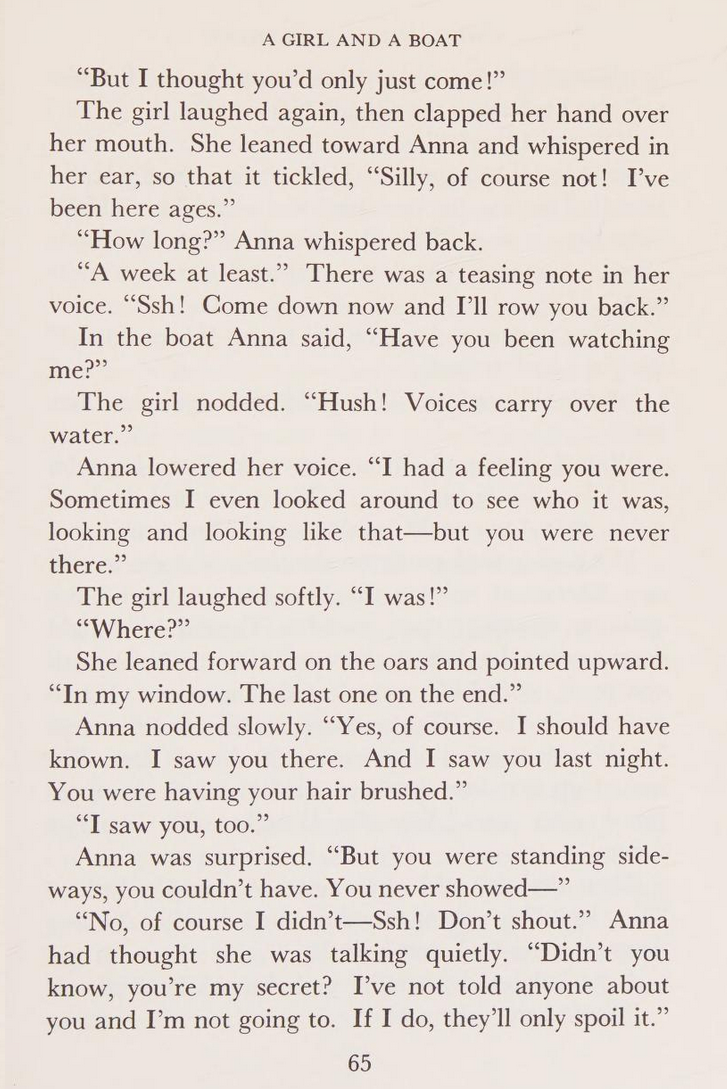
· On page 112, Anna muses that Marnie is the prettiest girl she’s ever seen, and then immediately spins it into another bout of self-loathing. Straight girls will do that to you.
· A few pages later, Anna discloses her darkest secret: her foster parents get a monthly stipend from the government to take care of her, and she assumes this means they don’t really love her, especially since she isn’t supposed to know about it. This prompts Marnie to touch Anna’s hair and say, “Dear Anna, I love you. I love you more than any girl I’ve ever known.” And then she wipes a tear off Anna’s face, and Marnie’s mood shifts – she’s “suddenly gay again.”
· In the literal next paragraph, Anna cannot stop smiling “for the pure joy” of knowing Marnie. She runs into the mean girl again on her way home and is totally unbothered by being called a “daft thing.”
· Chapter 17 is entitled “The Luckiest Girl in the World”, and it’s about Anna and Marnie holding hands and making an eternal friendship vow. About which “Anna had never been so happy in her life.”
· Marnie builds them a sandcastle to live in – “just you and me.”
· At the end of the chapter, when Marnie tells Anna that her cousin is coming to visit, she disclaims, “Darling Anna, you know I’d much rather be with you.”
· “Anna had to be satisfied with that. Marnie loved her best and would rather be with her. That was all she had wanted to hear.”
· Anna is like, mildly jealous of Marnie’s cousin, which I thought was very funny until page 236, when we learn that Marnie ended up marrying said cousin. Incest is fine if it’s heterosexual!
· On page 129, Anna laments that she needs Marnie more than Marnie needs her.
· The next time they meet, Marnie says she thinks love stories are dumb, but she does think she wants to get married someday. Anna doesn’t – “I might fall in love with someone who doesn’t love me. I probably would.” Jesus.
· Marnie tells Anna about some abuse she’s endured at the hands of her caretakers, and Anna is obviously furious. She tells Marnie she loves her more than any girl she’s ever known, paralleling their earlier conversation.
· Anna and Marnie’s penultimate meeting is in an abandoned silo that Marnie has always been afraid to enter. Anna goes to check it out alone, in hopes of reporting back to Marnie that she doesn’t need to be scared. She wants to do this because it’s something she can give to Marnie that her stupid-ass cousin/future husband can’t.
· When she gets there, she finds Marnie already inside, having a panic attack. To prove to her cousin that she could be brave, she climbed up there alone, and is now too petrified with fear to climb back down, so she and Anna end up passing out from exhaustion.
· Anna is awoken by the sound of Marnie’s cousin rescuing her. Marnie’s cousin does not rescue Anna. Anna feels so betrayed by this that she vows never to trust anyone again.
· The last time Anna and Marnie speak, on page 150, Marnie is locked in her bedroom, about to be sent away. She apologizes for abandoning Anna in the silo, and Anna forgives her. She tells Marnie she loves her, but Marnie doesn’t say it back.
· Fifteen chapters later, Anna finds out that Marnie is her dead grandma’s ghost.
THE FILM
Sometimes, if an old book is really gay, and it’s not supposed to be, I can talk myself out of it. I convince myself I’m visualizing it wrong; I’m not imagining the dialogue the way it would actually be performed. My twenty-first century sensibilities are making a mockery of 57-year-old literature. I’m gay, so everything I read must be. How reductive!
But if a recent movie is really gay, it’s just really gay.
Omoide no Mānī was directed by Hiromasa Yonebayashi, and co-written by Yonebayashi, Masashi Andō, and Keiko Niwa. They didn’t make very many changes to the source material beyond setting it in modern-day Japan and renaming every character save Anna and Marnie. The most significant update is that Anna is now an artist herself, and she cannot stop sketching Marnie and the house Marnie lives in. The second-most significant update is that Anna looks like this:
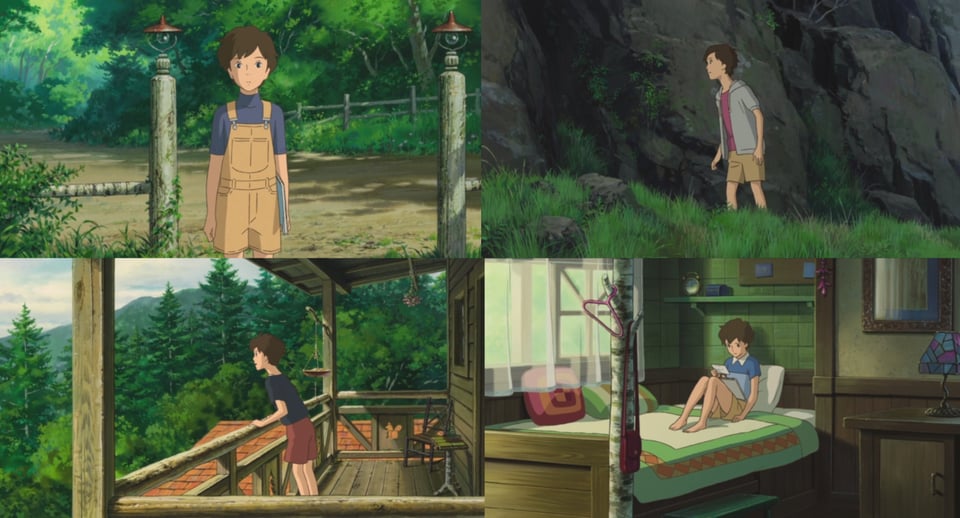
I GRANT YOU. I grant you. Marnie is always in old-fashioned dresses, because she’s a from another time, so it makes sense to give Anna a modern, casual style of dress in contrast. Likewise, Marnie has long, flowing hair that’s extremely outdated next to Anna’s messy chop. I am taking all of this into account when I dare you to tell me Anna’s hairstyle and wardrobe are not those of every baby lesbian you went to middle school with.
The third-most significant update to Robinson’s novel is that actually seeing Anna and Marnie’s interactions onscreen unfortunately removes any form of plausible deniability.
The scene where they meet, for instance:
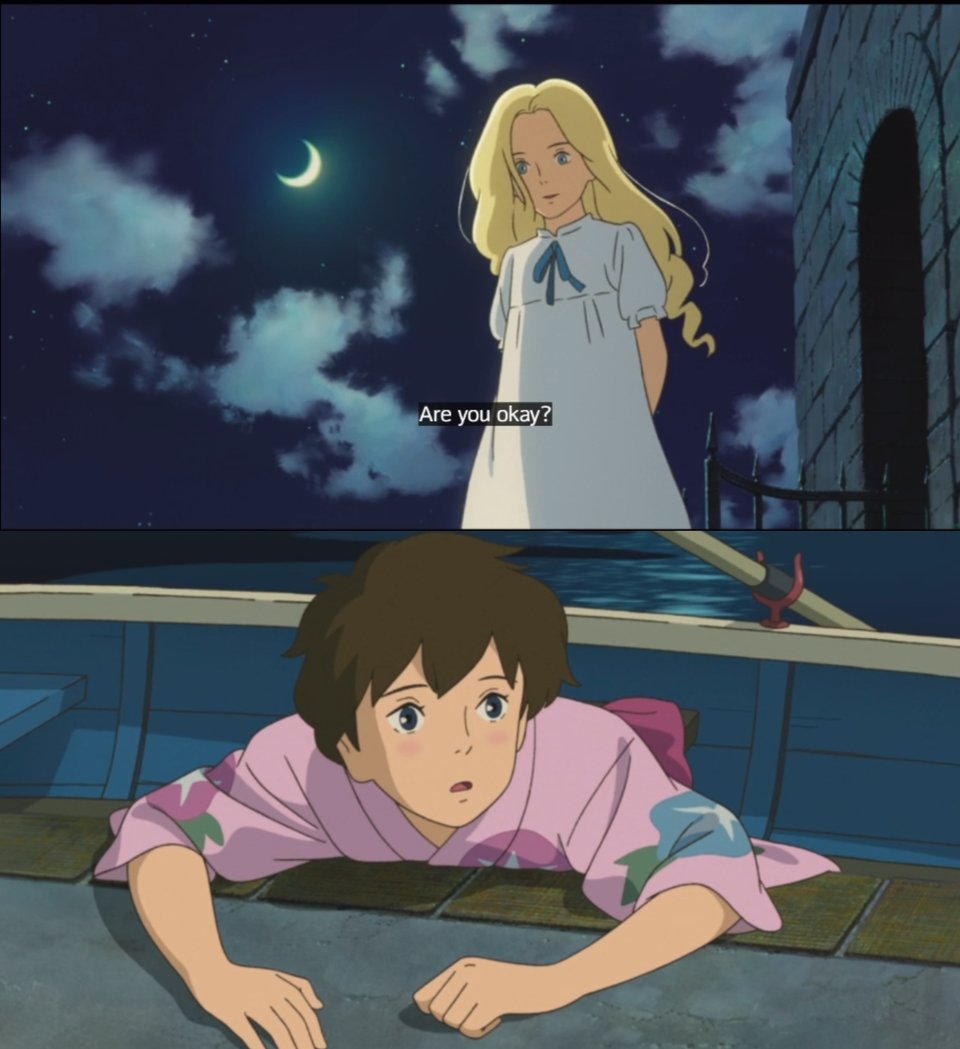
So Anna has just fled a local festival after a spat with that homophobic dachshund girl, stolen a rowboat, and made for that house she’s obsessed with. Unfortunately, she sucks at rowing, prompting Marnie to materialize and save her. When the boat is secure, and Anna is able to focus on her rescuer, the music swells, and she’s blushing????? See, that’s what I mean. That was a conscious choice. Someone at Ghibli drew that deliberately. In the 2010s. Knowing that Anna was actually gazing upon her dead grandma’s ghost. Why.
Anna’s like, “You look like the girl I saw in my dreams,” because did I mention she’s been seeing Marnie in her dreams? Marnie leads her up the stairs toward the house, and Anna almost trips, but Marnie catches her.
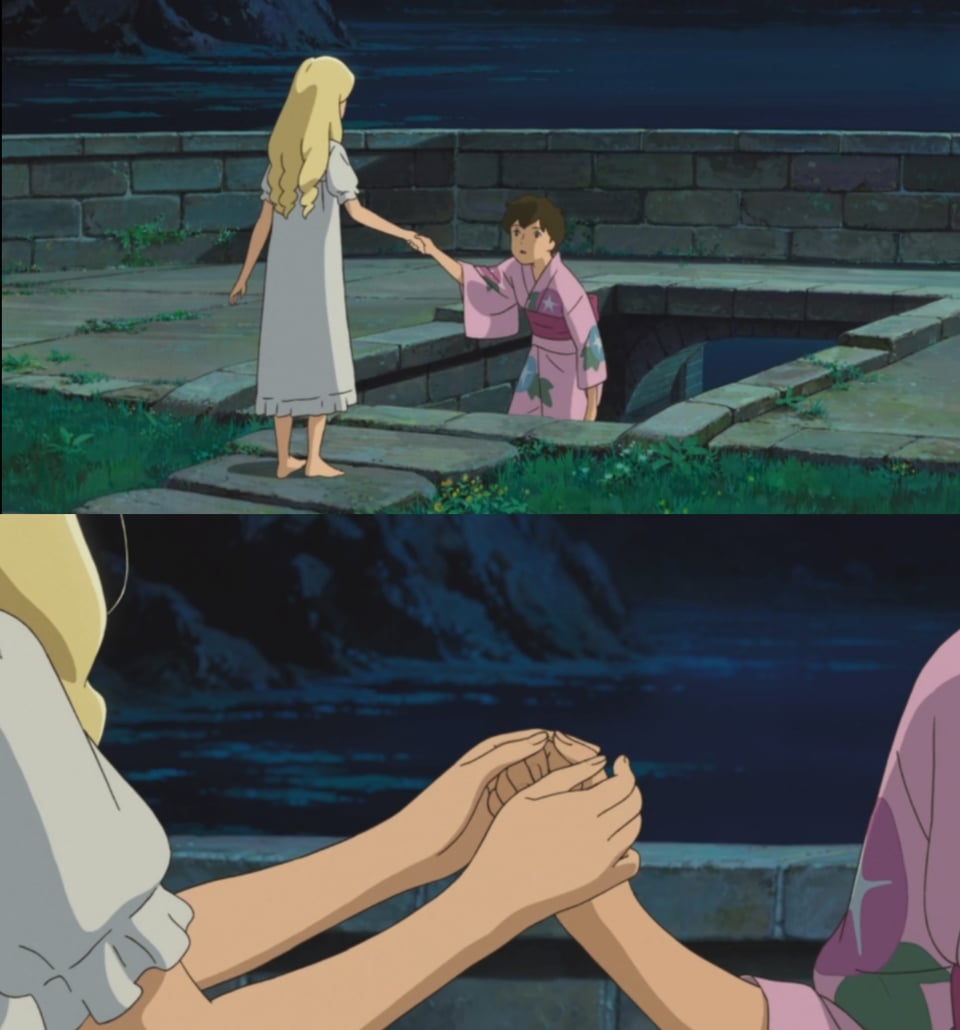
Again, whoever storyboarded this? Answer for your crimes.
They start to talk, but then Marnie’s parents come outside, so they have to hide behind a bush. Like this.
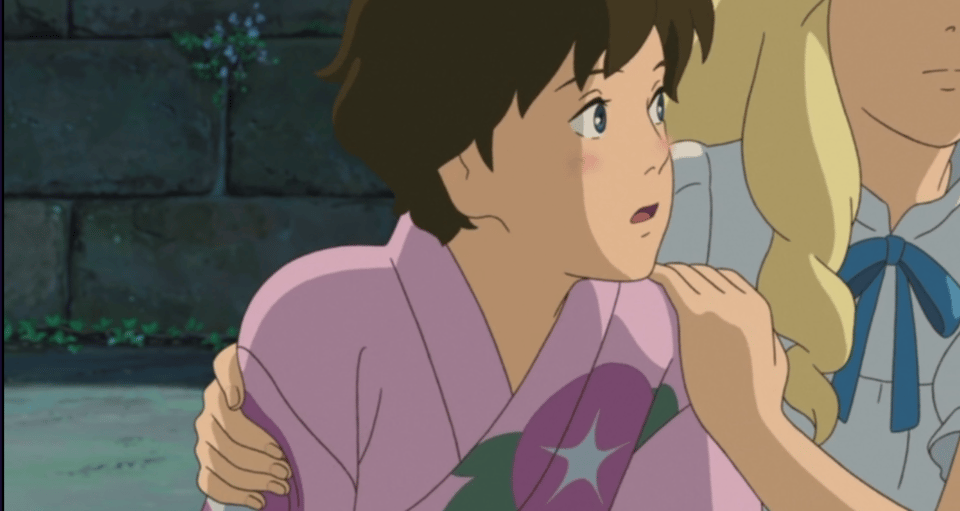
Marnie’s worried about getting caught, so she rows Anna back across the marsh to safety. On the way back, Marnie says some truly deranged things, like, “You’re my precious secret,” and “promise me that we’ll remain a secret forever,” and Anna’s like “Oh yeah, of course, of course, definitely.” They hold hands again, doubling up this time so you know it’s serious.
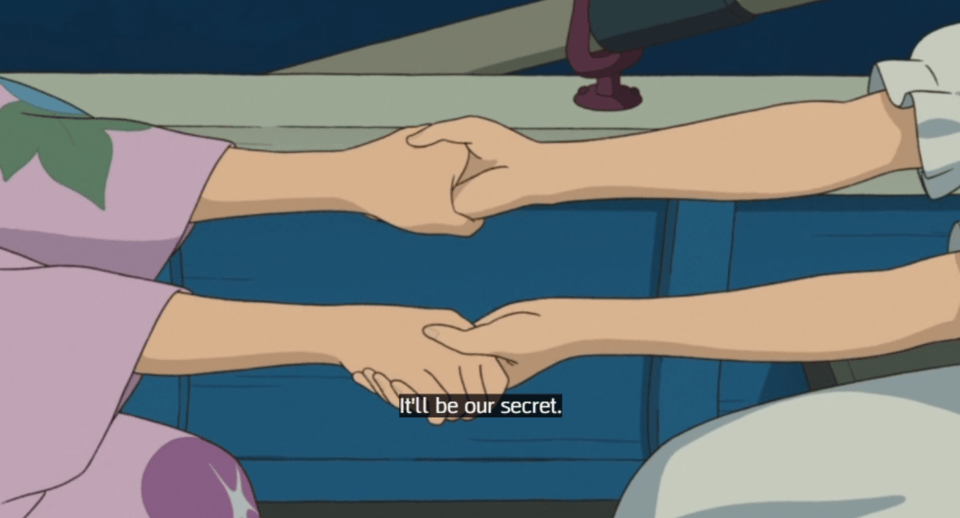
Then the music swells again, and we get this wide shot of the marsh.

VIBE CHECK! Marnie is the ghost of Anna’s dead grandma.
Anna goes home and does some sketches of Marnie, counting down the hours until high tide when she can row back over.
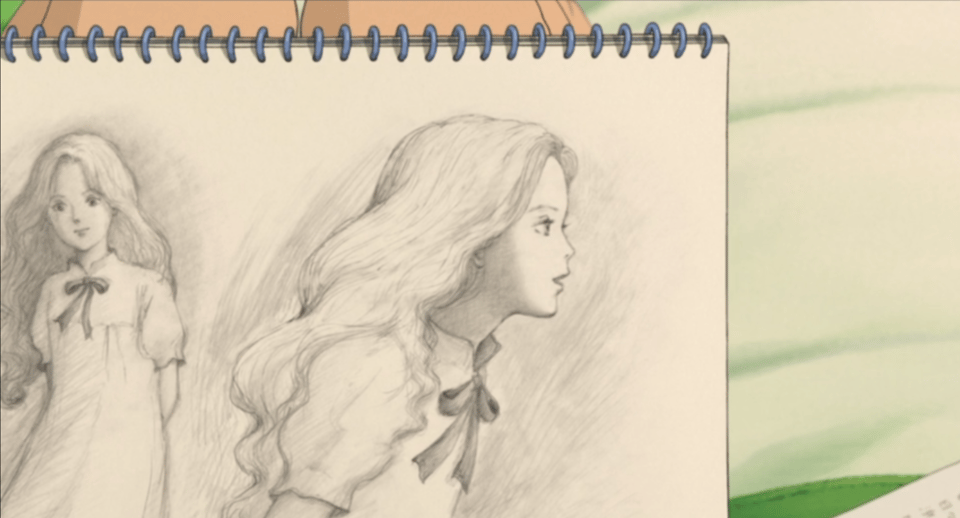
When she gets back to the shore, she finds Marnie already rowing towards her! Marnie’s like, “Let’s go have a picnic! Also, I’m teaching you to row, because you fucking suck at it.”
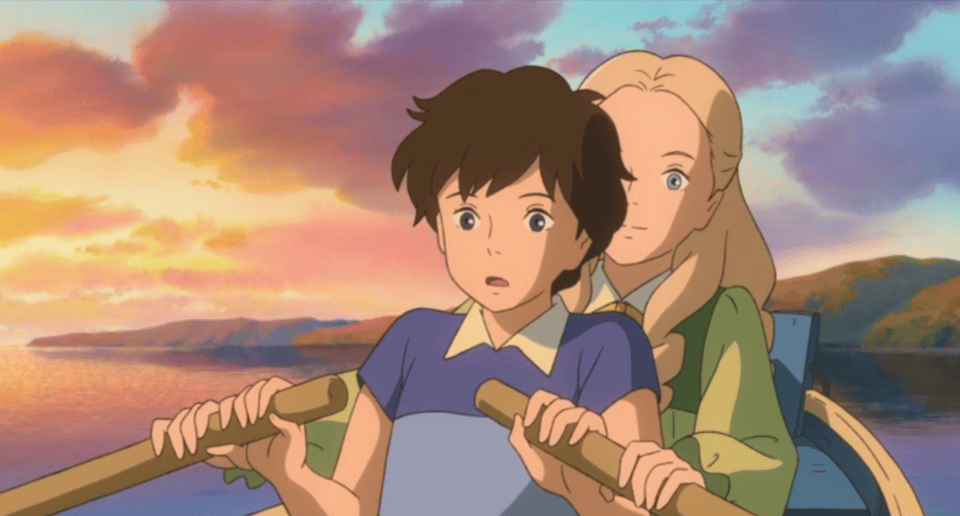
Look, I’ve never given or taken rowing lessons. This could be normal.
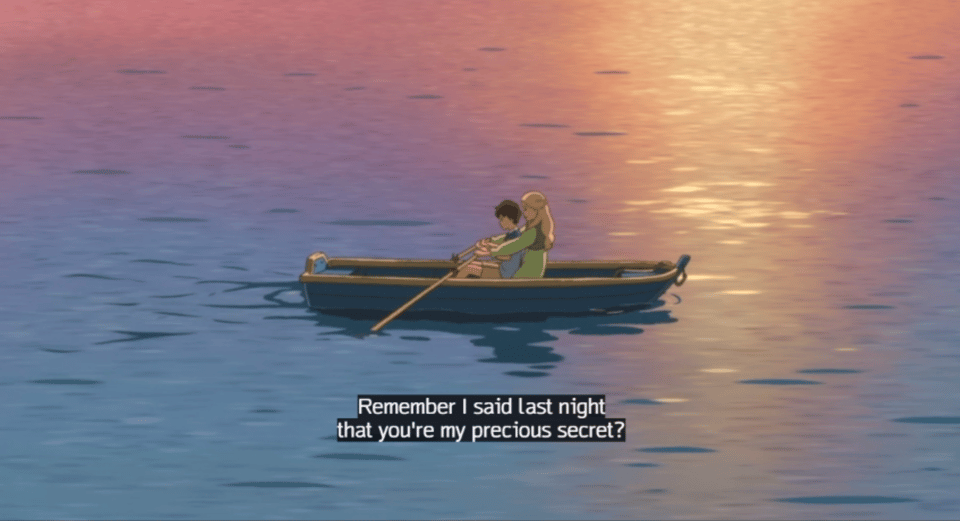
After like, thirty seconds, Anna is good enough at rowing that Marnie is comfortable doing an “I’m flying, Jack!” bit. In case Anna’s whole drawing thing wasn’t reminiscent enough of a certain other movie.
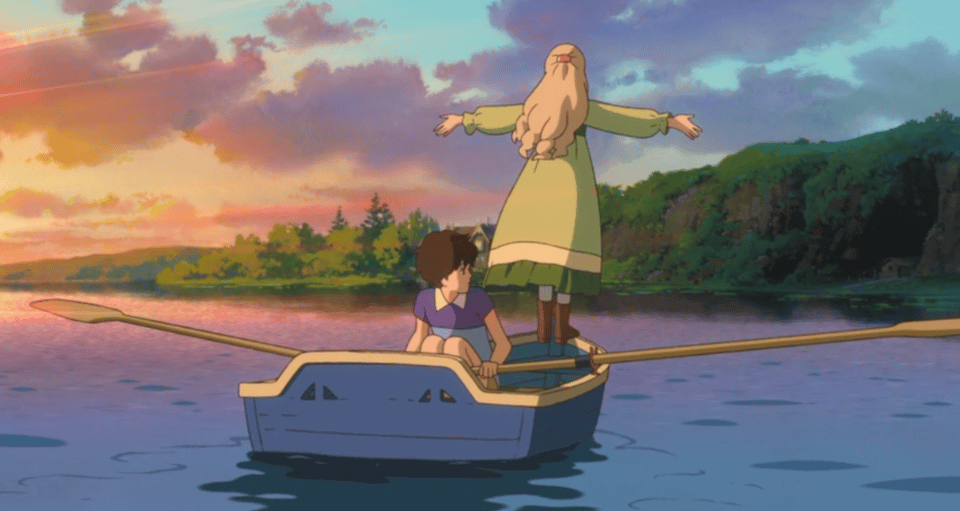
They have their picnic, and Marnie’s like, “Let’s ask each other three questions a night!” as though this is going to be a regular thing. I have three questions for the filmmakers, and I’ll let Liam Gallagher ask them for me.
Marnie asks Anna about life with her host family, and Anna dissociates, causing Marnie to disappear for like, two seconds. This is how Marnie reacts when they find each other again.
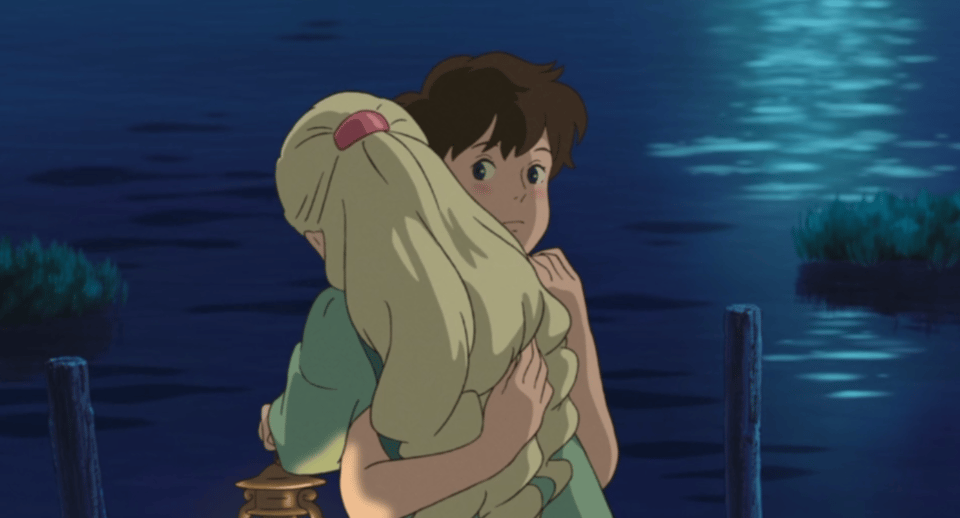
Marnie doesn’t want to stop hanging out, but she’s supposed to make an appearance at a party her parents are throwing. Her solution is to dress Anna up as a peasant, invite her in, and then ditch Anna for her future husband.
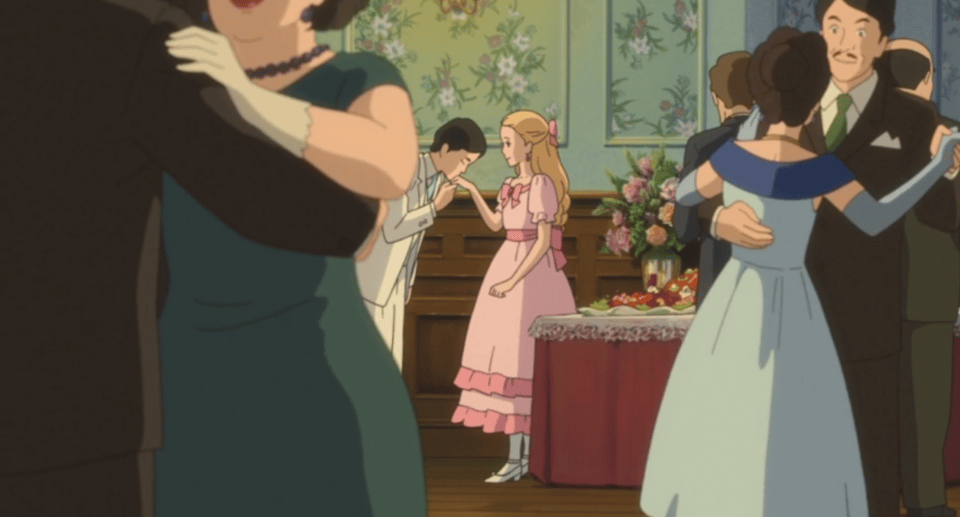
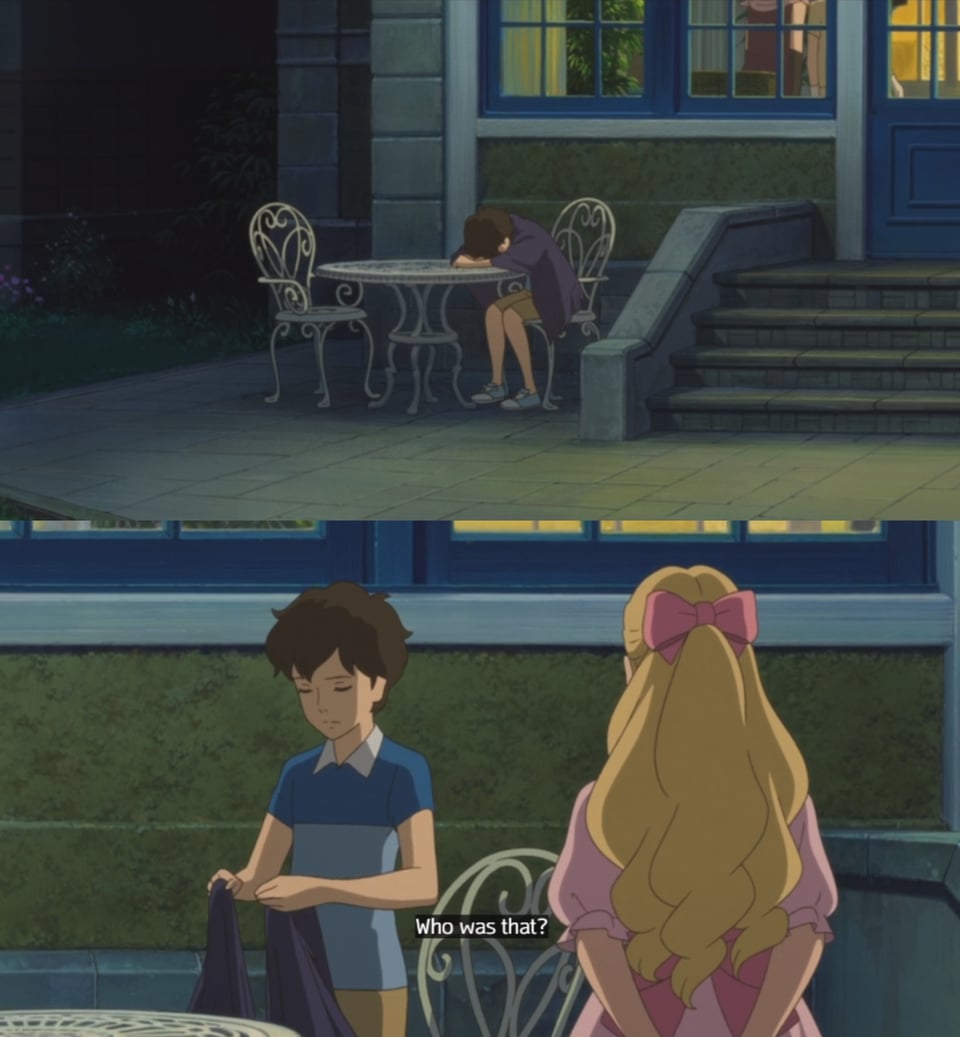
Anna bitterly tells Marnie she seems like a good dancer, and Marnie asks her to dance.
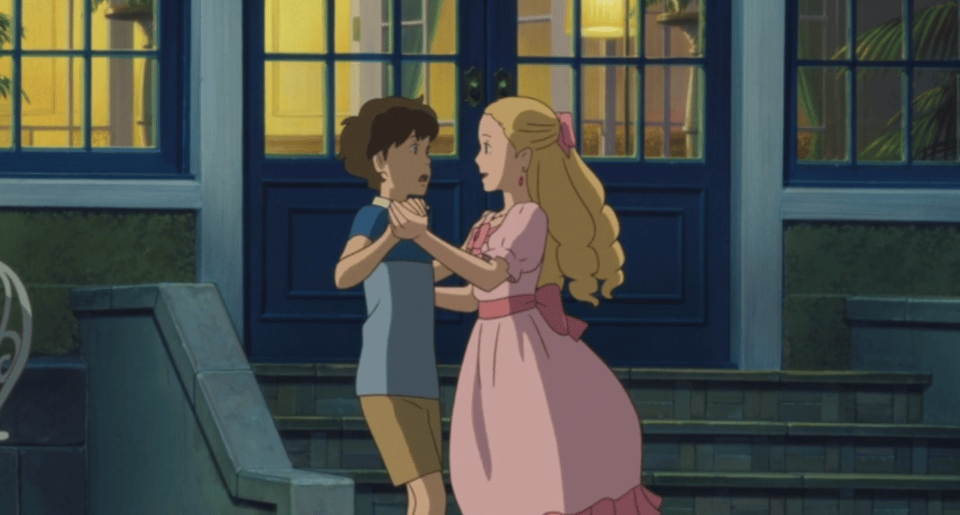
I was actually all set to write this one off as a cute friendship moment, due to Marnie being the ghost of Anna’s dead grandma and all, but then Anna stumbles, and they land like this.
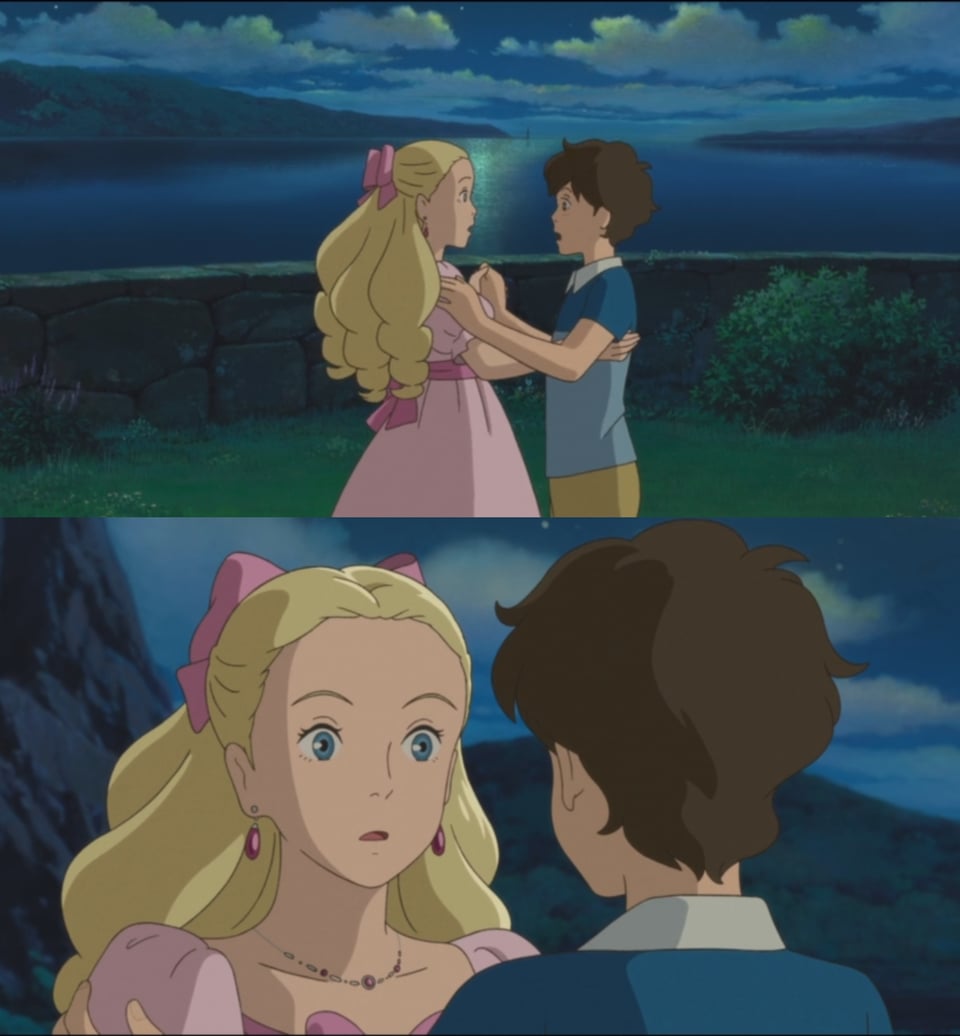
This is the first time we see Marnie with one of those “Oh shit, I’m in love” expressions Anna’s been sporting the entire time, forcing me to consider that I’ve been too hard on Marnie, because it would probably suck equally as much to be a ghost reliving your abusive childhood and having a posthumous bisexual awakening because of THE GRANDDAUGHTER YOU WERE RAISING BEFORE YOU DIED???? What circle of hell is this, and what did she do in life to deserve it? The movie is only half over, and I’m so tired. Why did they do this? Why did this happen?
They keep dancing, and then Anna wakes up on the side of the road. She doesn’t see Marnie for a while, and gets a few ghostly clues about what’s going on from that other painter and the girl who moves into Marnie’s old house. Ghostly, exclusively. Nothing familial. She keeps sketching, too.
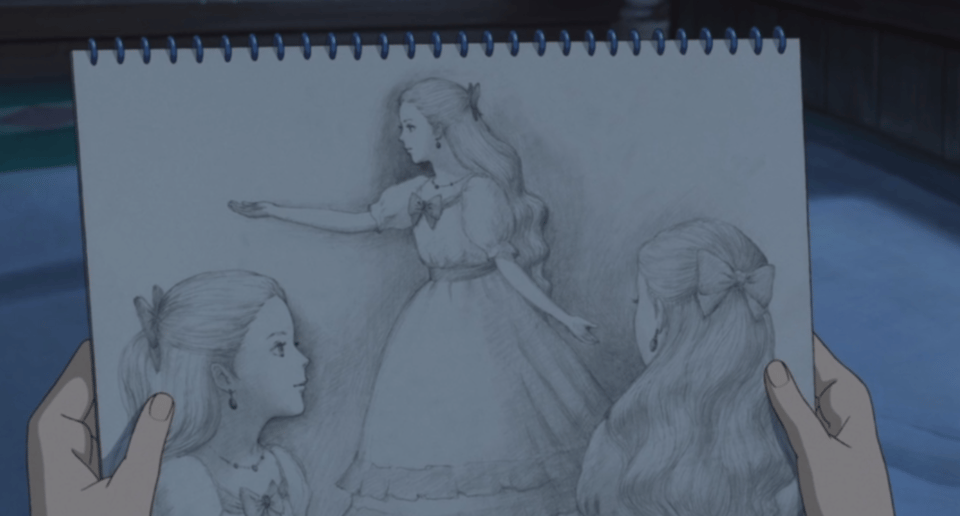
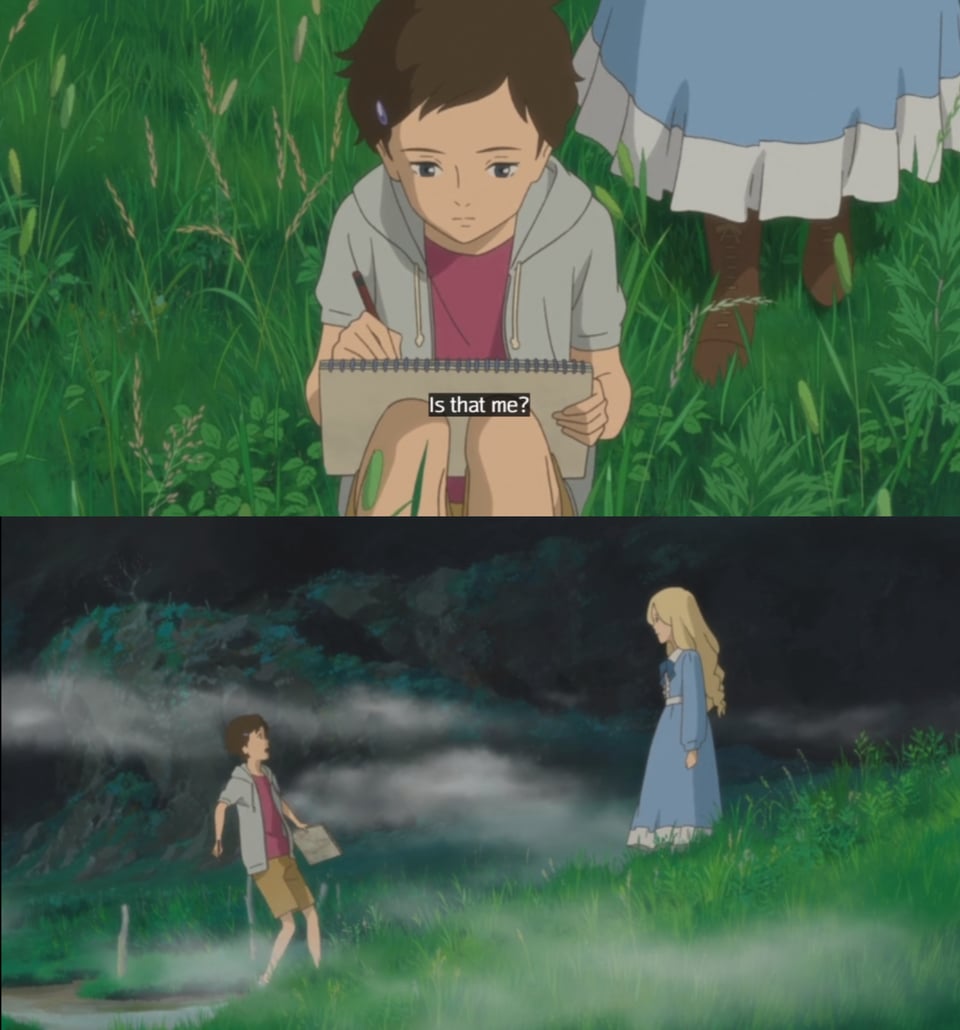
Anna gets over the initial embarrassment of being caught with her gay little sketchbook and throws her arms around Marnie, blushing again. I thought we were past this!
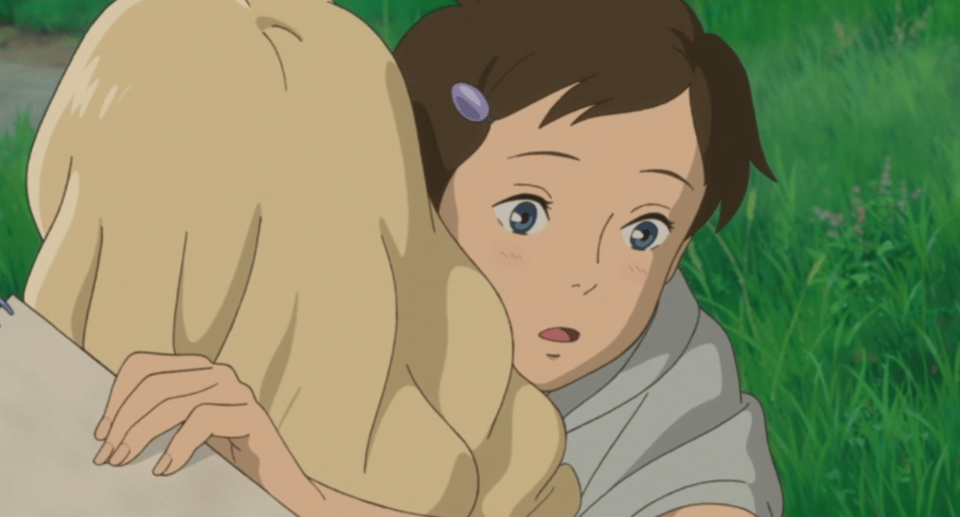
Anna’s all, “Where were you? I kept calling you in my heart,” like straight people say, and Marnie invites her over. Anna, starting to suspect Marnie isn’t real, invites Marnie to her house, and Marnie admits that she can’t really leave the immediate vicinity. Prompting…
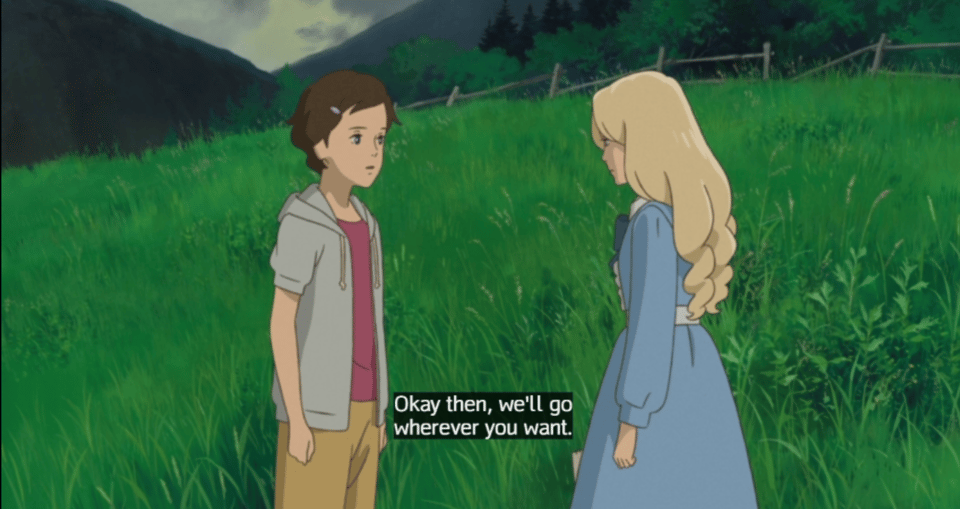
They go to the woods to pick mushrooms. Gross! This is where they each divulge the source of their emotional turmoil – Marnie’s abuse and neglect; Anna’s fear that her foster parents don’t love her, and are just in it for the government check. It’s a long, heavy scene full of harrowing flashbacks, and truly the last thing it needs is misplaced romantic subtext. Unfortunately…
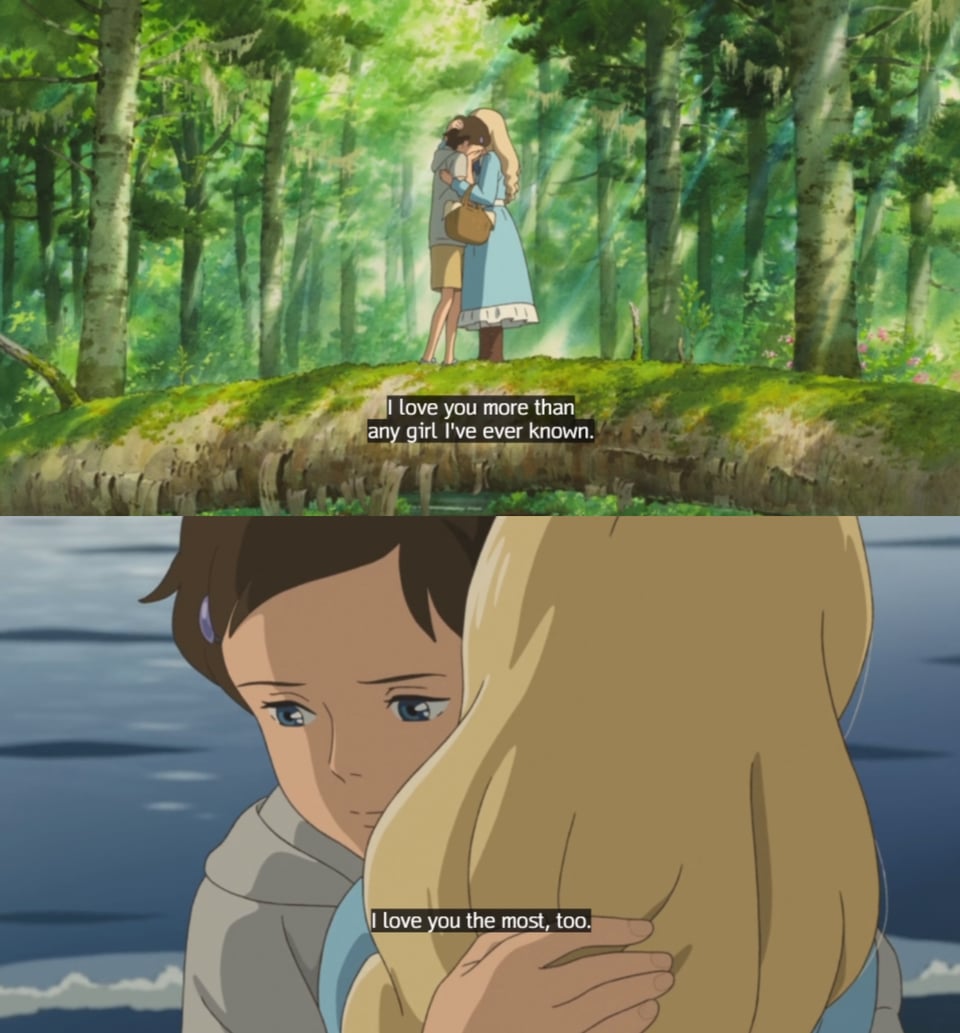
Anyway, this is when Marnie tells Anna about the time her evil maids tried to force her to climb the abandoned silo that she’s afraid of, and Anna suggests they go together so Marnie can conquer her fear. This, we will later learn, is the same idea Marnie’s husband had in the original timeline. Marnie’s husband being Anna’s grandpa. It never gets any easier to conceptualize!
They head for the silo, but Anna gets distracted by the girl currently occupying Marnie’s old bedroom, who has finally located the missing pages in Marnie’s diary. Marnie continues to the silo alone, and Anna chases her. When she gets there, a thunderstorm has started, and Marnie is already at the top of the silo, having a panic attack.
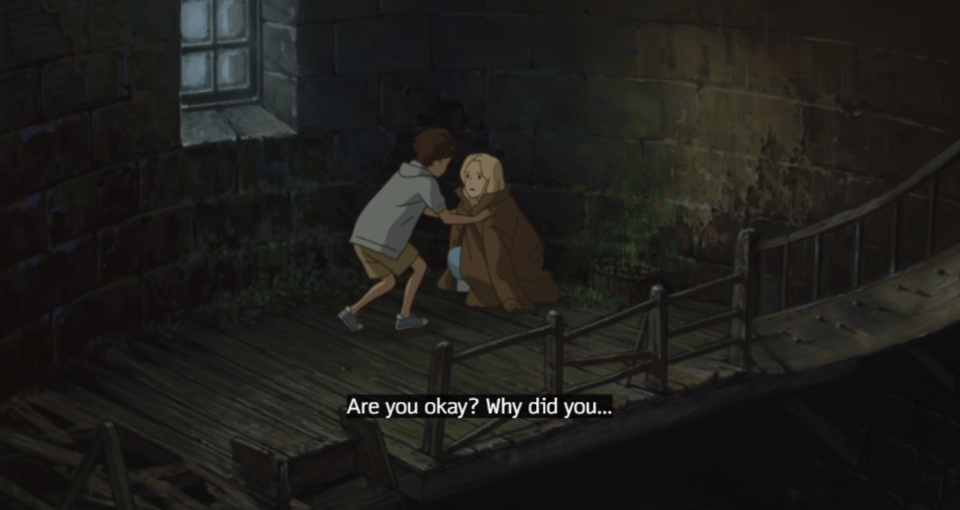
Anna herself is starting to get nervous about the storm, so she puts on a brave face, all, “Yay, you did it, you conquered your fear! I’m so proud of you! Let’s leave immediately!”
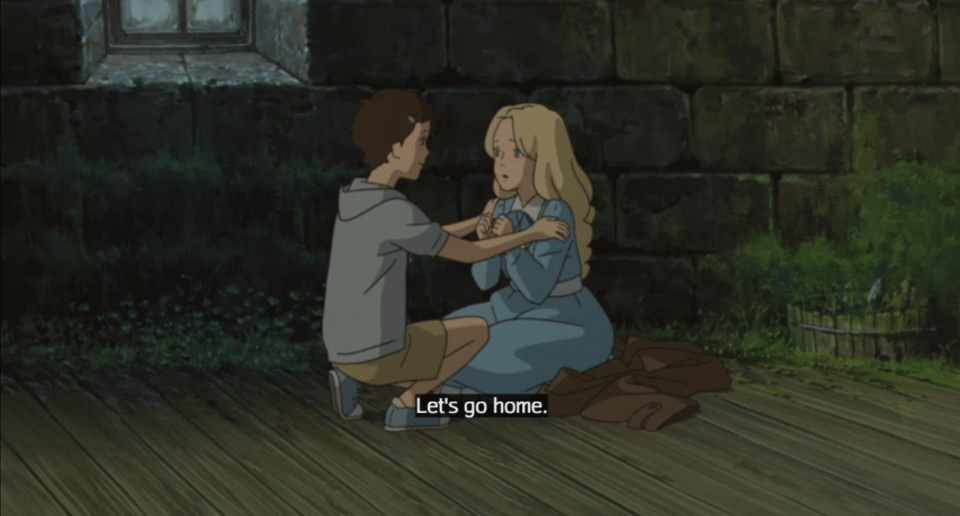
But Marnie is too freaked out to move, and Anna can’t find the ladder anyway. They just live in the silo now.
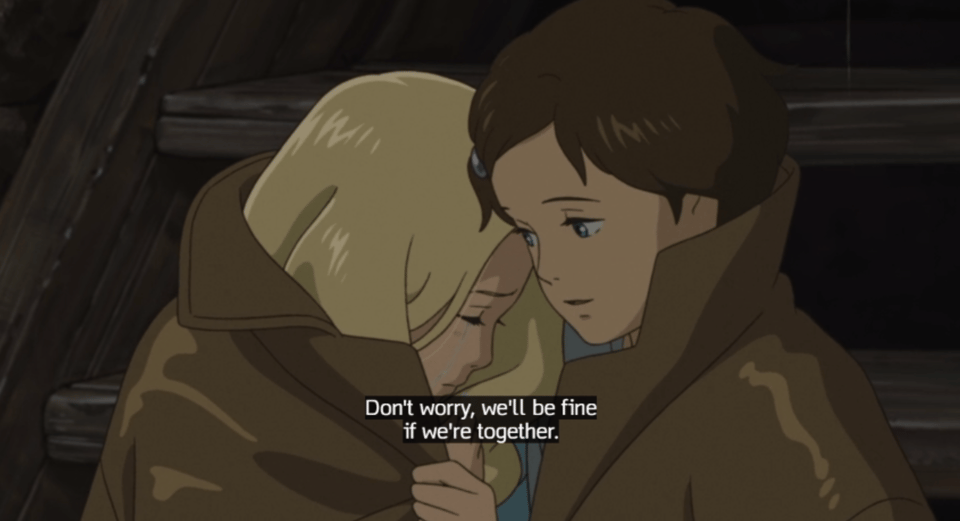
They both fall asleep, and Anna has two visions: of being put to bed as a baby by an elderly woman, and of Marnie being rescued by her future husband. Anna wakes up alone, feeling betrayed. She climbs down and starts sprinting home, but trips and falls unconscious. The kids living in Marnie’s old house find her face down on the ground, imminently dying of pneumonia and despair.
While she’s asleep, Anna dreams of Marnie one final time. Marnie apologizes for abandoning her, begs for forgiveness, and says she can’t stick around any longer. A sobbing Anna yells, verbatim, “Of course I forgive you! I love you, Marnie! And I won’t forget you! I’ll never forget you! Ever!”
Marnie says nothing in response; just smiles and closes her eyes. Go girl, give us nothing.
Anna’s fever breaks, and she reunites with the girl living in Marnie’s old bedroom, who has found a painting of the house done by the local painter. They track her down to get Marnie’s entire tragic backstory: neglectful parents, abusive caretakers, married her childhood sweetheart, moved to Anna’s hometown, had a daughter, husband died of illness, sent her daughter to boarding school, checked into a sanatorium for grief/shock, daughter felt abandoned and never forgave her, daughter got pregnant and ran away with boyfriend, had daughter of her own, died in a car crash with boyfriend, leaving granddaughter in Marnie’s care until Marnie also died of illness. Ten years ago.
At the end of the summer, Anna’s foster mom arrives to pick her up, and comes clean about the government stipend. She also gives Anna an old black and white photo of Marnie’s house, which a younger Anna wouldn’t let go of at the orphanage.

Oh, is this a good time for me to mention that Anna used to have a doll that looked exactly like Marnie?
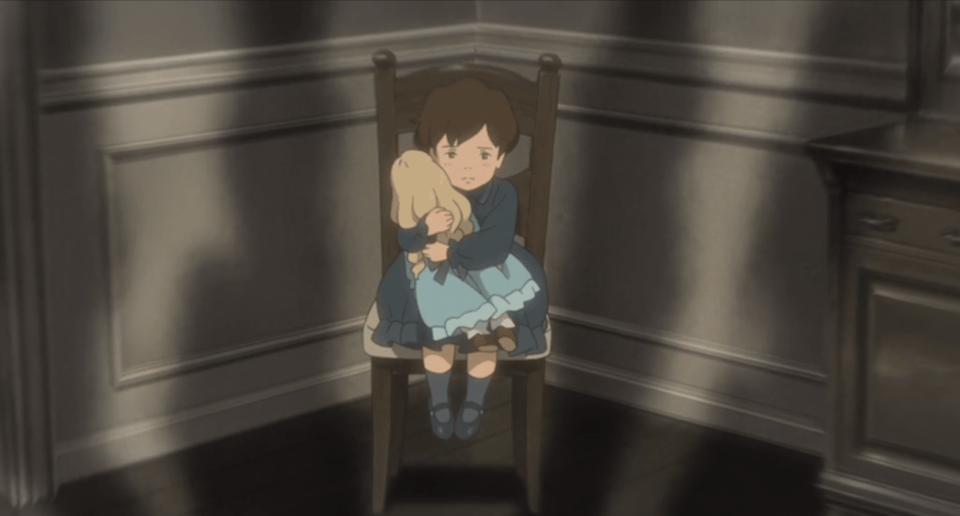
Anyway, this revelation prompts a series of flashbacks, from Anna and Young Marnie dancing together, to Old Marnie telling Baby Anna the silo story. This is the face Anna makes when she has her epiphany.
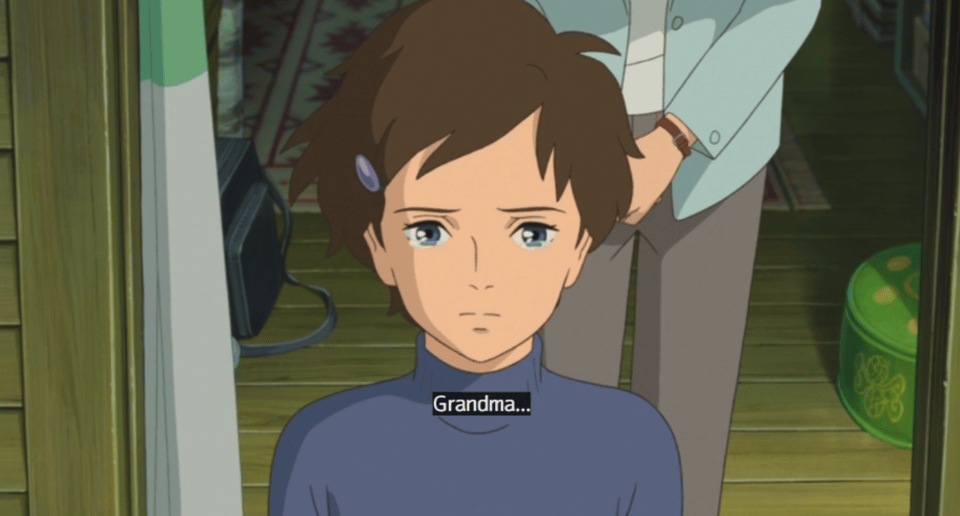
Anna seems to get over the whole First Crush Was Dead Grandma’s Ghost thing remarkably quickly, if her parting words to the painter are any indication.
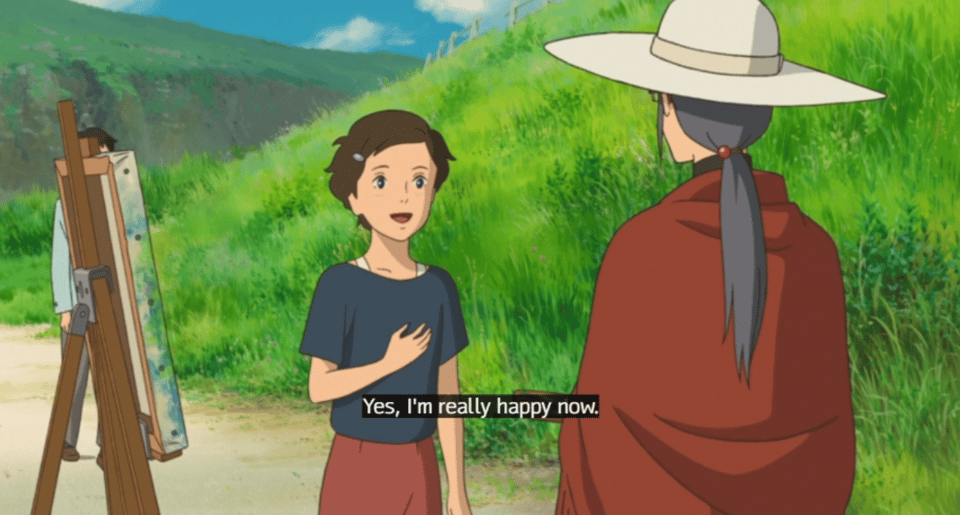
THE ENGLISH DUB
Is exactly as gay as the original. My only note is that Anna is voiced by Hailee Steinfeld, who I personally know best from 2016’s The Edge of Seventeen – a movie about an angry, depressed high schooler who takes it really, really poorly when her best friend starts dating her older brother. As in, threatening suicide to her teacher. Like Anna, this character is not textually queer, but come on.
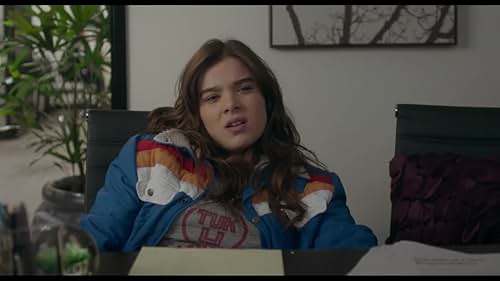
NOW WHAT?
I don’t not recommend When Marnie Was There, both book and movie, (especially the movie) but I’m not gonna tell you there isn’t something fundamentally broken about the central relationship. Which is a shame, because there really didn’t need to be! Joan G. Robinson’s editor could’ve taken her aside, and been like, “Hey, sooooooooo…” An entire animation studio surely employs at least one person who might perhaps have been cognizant of how some of Robinson’s dialogue was going to play to a modern audience. Especially if the characters are averaging at least one tearful embrace per scene.
Going into Marnie blind is actually the best case scenario, because this poor movie’s rewatch value is almost entirely contingent upon how funny your friends’ horrified reactions will be. Revisiting the film alone, as I’ve done, is just kind of weird and sad. It’s very nearly good, but…
I have one more comparison: From Up on Poppy Hill – a 2011 Ghibli film (also co-written by Keiko Niwa) centered around a teenage straight couple whose relationship is threatened when they find out they might be long-lost siblings. But then they’re not siblings. Umi and Shun are free to pursue their romance, unlike Anna and Marnie – the worst anyone’s ever done it. Don’t worry, straight kids! You’re free to be alive at the same time, and not related to each other! (I’M NOT BITTER.)
Still, Poppy Hill ends mere minutes after the post-reveal sigh of relief, and thus is almost as difficult to process as Marnie’s post-reveal disappointment. It’s the emotional equivalent of a near-death experience. When Marnie Was There, like its titular character, feels like realizing you’ve been dead all along. It’s no less rattling a decade later.